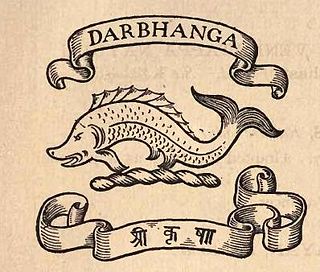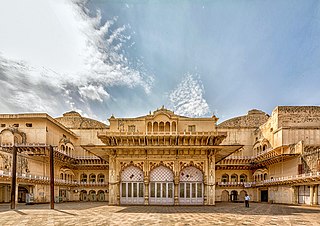Related Research Articles

The British Museum is a public museum dedicated to human history, art and culture located in the Bloomsbury area of London. Its permanent collection of eight million works is the largest in the world. It documents the story of human culture from its beginnings to the present. Established in 1753, the British Museum was the first public national museum.
Maharaja is an Indian princely title of Sanskrit origin. In modern India and medieval northern India, the title was equivalent to a prince. However in late ancient India and medieval south India, the title denoted a king.

Darbhanga is the fifth largest city and municipal corporation in the state of Bihar in India, and is considered an important city in North Bihar. It serves as the headquarters of the Darbhanga district and the Darbhanga division. Darbhanga is also referred to as the gateway to Bengal, because it is held that the name Darbhanga has been derived from Dwār Banga or Dari – Banga, meaning the 'door of Bengal'.

Patna Museum is the state museum of the Indian state of Bihar. Founded on 3 April 1917 during the British Raj to house the historical artefacts found in the vicinity of Patna, it is constructed in the style of Mughal and Rajput architecture, and is known locally as the Jadu Ghar. Artefacts from the ancient India era to 1764 have now been transferred to Bihar Museum.

The National Museum in New Delhi, also known as the National Museum of India, is one of the largest museums in India. Established in 1949, it holds a variety of articles ranging from the pre-historic era to modern works of art. It functions under the Ministry of Culture, Government of India. The museum is situated on Janpath. The blueprint of the National Museum had been prepared by the Gwyer Committee set up by the Government of India in 1946. The museum has around 200,000 works of art, mostly Indian, but some of foreign origin, covering over 5,000 years.

Sir Bhupinder Singh was the Maharaja of Patiala and a cricket player. Singh's reign as Maharaja of the princely state of Patiala, in British India, lasted from 1900 to 1938. He was a member of the Phulkian dynasty. During his reign, Singh was most noted for his extravagance, contributions to sports, and for being an ally to the British Raj.

The Darbhanga Raj, also known as Raj Darbhanga and the Khandwala dynasty, was a Maithil Brahmin dynasty and the rulers of territories, not all contiguous, that were part of the Mithila region, now divided between India and Nepal. The rulers of Raj Darbhanga were Maithil Brahmins and their seat in the town of Darbhanga became the core of the Mithila region as the rulers were patrons of Maithil culture and the Maithili language.

Yadavindra Singh was the ninth and last ruling Maharaja of Patiala from 1938 to 1947. Singh kept his royal titles until 1971, when princely titles were abolished through the 26th Amendment to the Constitution of India. In his life, Singh was also a diplomat, sports administrator and former cricketer who played one Test in 1934.

The Ramnagar Fort is a fortification in Ramnagar, Varanasi, India. It is located near the Ganges on its eastern bank, opposite to the Tulsi Ghat. The sandstone structure was built in 1750 by Kashi Naresh Maharaja Balwant Singh. The current king and the resident of the fort is Anant Narayan Singh, who is also known as the Maharaja of Benares even though this royal title has been abolished since 1971.

Maharaja Sir Lakshmeshwar Singh, Maharaja of Darbhanga was the Zamindar and principal landowner of Darbhanga in the Mithila region, presently in the state of Bihar, India. His philanthropic works, administrative abilities and management of his estate were highly appreciated and led to development of his estate.

Anand Bagh Palace is a palace situated in town of Darbhanga in the Indian state of Bihar. Anand Bagh Palace was constructed during the reign of Maharaja Lakshmeshwar Singh in the 1880s and was severely damaged during the 1934 Nepal–Bihar earthquake. It was rebuilt thereafter.

Nargona Palace is situated at Darbhanga in State of Bihar, India. This Palace was the last royal Brahmin palace to be built in Raj Darbhanga.

The City Palace, Jaipur is a royal residence and former administrative headquarters of the rulers of the Jaipur State in Jaipur, Rajasthan. Construction started soon after the establishment of the city of Jaipur under the reign of Maharaja Sawai Jai Singh II, who moved his court to Jaipur from Amber, in 1727. Jaipur remained the capital of the kingdom until 1949—when it became the capital of the present-day Indian state of Rajasthan—with the City Palace functioning as the ceremonial and administrative seat of the Maharaja of Jaipur. The construction of the Palace was completed in 1732 and it was also the location of religious and cultural events, as well as a patron of arts, commerce, and industry. It was constructed according to the rules of vastushastra, combining elements of Mughal and Rajput architectural styles. It now houses the Maharaja Sawai Man Singh II Museum, and continues to be the home of the Jaipur royal family. The royal family has around 500 personal servants. The palace complex has several buildings, various courtyards, galleries, restaurants, and offices of the Museum Trust.The MSMS II Museum Trust is headed by chairperson Rajamata Padmini Devi of Jaipur. Princess Diya Kumari runs the Museum Trust, as its secretary and trustee. She also manages The Palace School and Maharaja Sawai Bhawani Singh School in Jaipur. She founded and runs the Princess Diya Kumari Foundation to empower underprivileged and underemployed women of Rajasthan. She is also an entrepreneur. In 2013, she was elected as Member of the Legislative Assembly of Rajasthan from the constituency of Sawai Madhopur.

Navlakha Palace, also known as Rajnagar Palace, is a royal palace in the town of Rajnagar, near Madhubani in Bihar, India. The palace was built by Maharaja Rameshwar Singh of Darbhanga.
Hetukar Jha was an Indian author, professor, researcher, and Fulbright Scholar. He was an honorary managing trustee of the Maharajadhiraja Kameshwar Singh Kalyani Foundation.

Darbhanga Medical College and Hospital is a government medical college having multiple healthcare facilities and is located in Darbhanga, Bihar. It was established in the year 1923. It is ranked 3rd in Bihar and 94th in India by IIRF 2023 ranking. College is currently affiliated with Bihar University of Health Sciences.

Maharajadhiraj Sir Kameshwar Singh Goutam Bahadur, K.C.I.E. was the Maharaja of Darbhanga. He held his title over his family estates in the Mithila region from 1929 – 1952, when such titles were abolished following the Independence of India. He had a sister named Lakshmi Daiji.
Chandradhari Museum which was established by the state government in 1957, It is situated at Darbhanga in Bihar, Originally situated on the eastern bank of Mansarowar Lake, The museum was shifted to the present double-storied building in 1974.

Government Museum, Alwar is a museum located in the Vinay Vilas Mahal of City Palace Alwar in Rajasthan, India. The museum collection captures the cultural, historical, and military past of Rajputana. It emerged from the interest of the royal house of Alwar in collecting specimens of exquisite artistry. The collection was formally opened as a museum in 1940. The building also serves as space for many government offices. This 18th century palace, built by Maharao Raja Vinay Singh, third ruler of Alwar State, is an amalgamation of Mughal and Rajput architecture. The museum houses a collection that comprises 234 sculptures, 11 inscriptions, 9702 coins, 35 metal objects, 2565 paintings and manuscripts, 2270 armoury items and 1809 miscellaneous objects of local craftsmanship. Looking at the predominance of paintings, manuscripts, and weapons, its curator in the 1960's, P. L. Chakravarti, called it a socio-military museum.

Dhaut Pariksha or Dhout Pariksha was the highest examination system established in Mithila during the Darbhanga Raj Kingdom.
References
- ↑ "Maharaja Lakshmeshwar Singh Museum, Famous Museum in Darbhanga". www.darbhangaonline.in. Retrieved 14 September 2022.
- ↑ "Maharajadhiraja Lakshmishwar Singh Museum – Global InCH- International Journal of Intangible Cultural Heritage" . Retrieved 11 November 2022.
1. ^16 November 2017 cm-revisits-history-at-twin-museums The Telegraph
2. maharaja-laxmiswar-singh-museum-in-darbhanga
3. payment-delay-hits-conservation-of-rare-items-manuscripts-in-patna-and-darbhanga-museums
4.Maharajadhiraja-Lakshmishwar-Singh-Museum